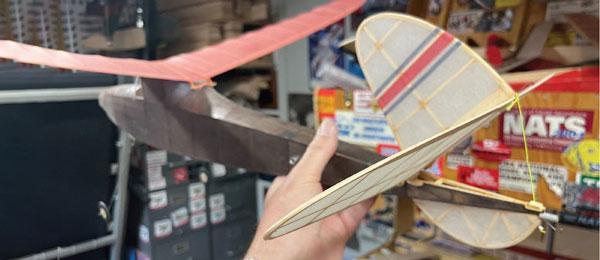Using Dethermalizers

Using Dethermalizers
Free Flight Sport
By | [email protected]
As seen in the August 2023 issue of Model Aviation.

A typical DT arrangement on a FF Hand-Launch Glider (HLG). The tailboom pops up when the viscous timer on the nose releases a hold-down line.
IN THE EARLY DAYS of Free Flight (FF), before approximately 1925, models were crude and inefficient. Few could fly more than a few seconds to only nearly a minute, and very few got high enough to worry about thermal air currents.
By the 1930s, balsa replaced hardwoods and bamboo as the primary construction materials, making models lightweight and improving performance considerably. At roughly the same time, the twin pusher-style Rubber model was supplanted by the more practical single-tractor monoplane.
Airfoils got better, excellent kits became available, and FF models began getting high enough to sometimes disappear into thermal updrafts. Modelers of the time recalled that it was common to travel to a weekend contest with three or four models and return with only one or two because of flyaways.
Around 1940, a few intrepid modelers began experimenting with ways to save models from flyaways, and the dethermalizer (DT) was born. One early DT method was to hinge a rudder tab that spun the model to the ground. This idea didn’t stick because models were too easily damaged from a spinin. Another method that was tried and abandoned was a parachute deployed from the fuselage, which worked okay but was cumbersome, heavy, and not practical for smaller models.
Pop-Up Stabilizer
Contest modelers eventually settled on the pop-up stabilizer. The idea was elegant and simple: Some type of actuator—either a slow-burning fuse or a mechanical timer—released the spring-loaded trailing edge of the horizontal stabilizer to an abrupt 35° to 45° angle. This immediately pitched the nose up and stalled the wing, breaking the model out of lift and into a slow and safe descent.

This HLG shows the typical pop-up tailboom/stabilizer that is actuated by a viscous timer.
The pop-up stabilizer is still the ideal DT method for most FF Sport models in the 16- to 36-inch wingspan and 1/2- to 7-ounce weight range.
Pop-Up Wing
Throughout the decades, modelers kept improving on the DT concept. It was found through trial and error that some of the lighter models, such as P-30s and Embryos, wouldn’t descend fast enough with a pop-up stabilizer, and sometimes kept ascending under stabilizer DT. Something had to be done to increase the sink rate of these high-flying lightweights.
Pop-Off Wing
The surest way to bring a model down is a pop-off wing, a method still used by a few contest fliers in the P-30 and Coupe d’Hiver events. The earliest reference I could find to a pop-off wing was the Gully II P-30 of John Ferrer in the late 1970s. A fuse burned through the rubber band holding the wing onto the fuselage. The wing was tethered behind the fuselage on the rapid descent. This method is foolproof but should only be used on the lightest models where stabilizer DT is ineffective.
Pop-off wing models hit the ground really hard, so be sure that you’re not flying over a lot of pavement or rocks. They can also bite you in heavily treed areas. At the 2015 and 2021 AMA Outdoor FF Nats in Muncie, Indiana, I watched helplessly as two very good P-30s DTed straight into tall trees. The wing tether lines got hopelessly tangled in the branches and the models were lost.
Burning Fuse
The slow-burning cotton fuse is still a simple, lightweight, and reliable DT actuator. The fuse burns through a hold-down band and up comes the stabilizer. Best of all, fuse DTs are cheap—small orthodontic rubber bands and a few feet of cotton fuse—and cost less than $5 for a season of flying. Fuse DTs must be used with care, however, and should probably be avoided at dry/windy flying sites.

The simplest and lightest DT system is still the fuse-activated pop-up stabilizer.
Viscous Timers
Not much more expensive than fuses, and costing approximately $10 to $20, are tiny viscous fluid timers that are available from various FF suppliers. These little marvels operate on spring or rubber band tension. The thick fluid (similar in viscosity to Silly Putty) allows an impeller to move very slowly through it before releasing the hold-down line.

The Volaré Products Wisp shows a simple popup wing arrangement with a viscous timer.
The downside to viscous timers can be their frustrating inaccuracy. A 2-minute setting on a cool morning can speed up to 90 seconds or less in the afternoon. Their big upside is their light weight; they typically weigh only 2 grams ready to fly.
Mechanical Timers
Mechanical timers are still used for larger FF aircraft such as glow-powered AMA Gas models. They are accurate and reliable but too heavy (approximately 10 to 25 grams) for any model weighing less than 5 ounces.
Electronic Timers
A recent development is the electronic timer. It is super accurate to .1 second, lighter than mechanical timers, and feature rich, allowing electronic motor run timing and DT actuation. The lightest and most compact timers burn through a tiny rubber band and weigh barely more than a gram. Some even have a plug for a radio DT receiver.

A pop-up wing DT and lightweight electronic band burner timer on a small Duration model.
Radio DT
Radio DT is undoubtedly the ultimate DT solution. The flier launches the model and has a transmitter at the ready, similar to a car’s keyless remote. When the model gets too close to a pond, trees, crops, powerlines, etc., press the button and down it comes. These systems cost anywhere from $150 to $300 with batteries and are becoming quite lightweight. Most weigh approximately 4- to 5-grams installed in the model, and you can move receivers easily from model to model.
Not only are they ideal for contest flying, but they can also make Sport and test-flying on smaller sites very practical.
SOURCES:
National Free Flight Society (NFFS)
J&H Aerospace










1 comments
Freeflight Dethermalizers Article
Add new comment